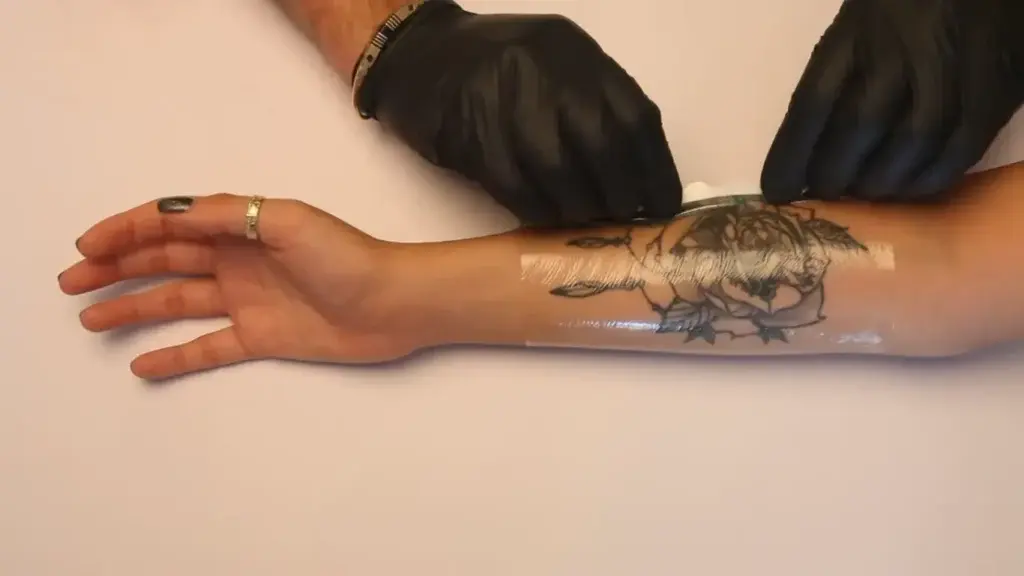How To Waterproof A Tattoo For Swimming?: Dos & Don’ts
A new tattoo usually takes three to four weeks for proper healing. During healing, you must keep your tattooed skin away from swimming or the local pool, as it’s essential for aftercare. Although the cool embrace of swimming water in the hot summer is like a refreshing oasis for the soul, it’s best to avoid swimming with a new tattoo because it can soon cause the ink to lose its vividness.
Even exposing freshly tattooed skin in a swimming pool can lead to infection or irritation in the wound. However, if you still want to swim with a fresh tattooed skin, ensure it is waterproof. By following some proper tips or methods, you can protect your tattoo from pool water to avoid such damage.
Key Takeaways:
To Protect Your New Tattoo Before Swimming:
Here are two options:
- Not Recommended: Apply a thin layer of petroleum jelly over your tattooed skin.
- Recommended: Use a specifically designed waterproof bandage, such as Saniderm.
Alternatively:
Avoid submersion: If a waterproof bandage isn’t an option, keep the tattoo out of the water as much as possible.
After Swimming:
- Clean Gently: Rinse the tattoo with clean, lukewarm water and pat it dry with a clean, non-woven cloth. (Perfect!)
- Use Fragrance-Free Aftercare lotion: Apply a thin layer of a fragrance-free ointment or lotion specifically designed for tattoo aftercare.
Allow Your Tattoo To Heal Fully
Before moving on to waterproof tattoos, I recommend avoiding exposing your application area to a swimming pool until it completely heals. A tattoo usually takes 3 to 4 weeks to heal properly, but healing time depends on the tattoo’s placement, size, and other factors.
We talked to Dr. Garcia, a skin expert, and asked her advice on whether we should swim with a new tattoo or not.”
She replied: “Remember, it’s not safe to swim in pools or the ocean with a new tattoo. Avoid getting it wet for at least 4 weeks. Chlorine in pools dries out skin, and saltwater irritates it. Plus, pools and river are full of germs, which can infect your healing tattoo. Keep it dry and clean for a healthy recovery.”
How To Waterproof A Tattoo For Swimming?
Following are some essential tips for tattoo water protection.
Use Waterproof Aftercare Products
Before exposing your tattoo to a water pool, apply a thin layer of lotion or similar products like Petroleum jelly on your application area. I recommend petroleum jelly because of its waterproofing properties, as it will provide an additional protective covering when applied to the tattoo. Its active agents will prevent water contact with the ink design.
However, avoid using a heavy coat of Petroleum jelly on the fresh tattoo. Doing so may result in faster tattoo fading. Additionally, petroleum jelly can block the airflow that newly tattooed skin needs to breathe to heal properly. Moreover, petroleum jelly forms a thin, oily layer on tattooed skin, which can trap existing moisture.
This excessive moisture can slow down the healing process. Alternatively, you can apply Vaseline. These aftercare products will protect your tattoo from irritation and also minimize water contact.
Use Waterproof Tattoo Bandage For Swimming
If swimming with a new design is necessary, you must protect your tattoo from water. Although you cannot fully waterproof it, you can minimize its contact with water to avoid some potential damage.
One of the most effective ways to keep your new ink design safe is to use a waterproof tattoo bandage for swimming. Second skin, like Saniderm, is the most commonly used water-repellent bandage. It works well to protect your tattoo from water. So, before entering the water pool, cover the inked area with a waterproof bandage.
You can also add more protection layers on the second skin. For example, wearing a rash guard will be an excellent choice to cover your entire design area if you have a shoulder tattoo. However, some individuals cover their tattoos using plastic wrappers, which is unsafe. So, when you have done swimming, remove the dressing carefully.
Dr. Smith, a leading dermatologist, recommends using Second Skin bandages for waterproof protection during tattoo healing. These breathable yet waterproof bandages, such as Saniderm and Tegaderm, provide an effective barrier against moisture.
Tips to Follow After Swimming
Wash The Tattooed Area With Lukewarm Water And Mild Soap
Once you have finished swimming, dry and remove the tattoo wrap carefully to avoid water flowing over the ink design area. Then, rinse the tattooed skin and surrounding area thoroughly with lukewarm water to prevent Irritation. Use a fragrance-free, antibacterial soap specifically formulated for tattoo aftercare to clean it. However, it’s essential not to use harsh chemicals or scrub your ink design vigorously. This can damage the tattooed areas, which can slow the healing process.
Clean The Inked Area With A Towel
After cleaning the tattooed area with water:
- Dry it with a clean towel.
- Dab it on the tattoo area gently.
- Avoid rubbing or scratching the tattooed skin and spurring skin, as it can damage it or lead to infection.
Apply Moisturizer Or Lotion
Once the skin dries after this process, apply moisturizer or a good-quality lotion recommended by your tattoo artist. Ointment is necessary and part of aftercare to keep the skin vibrant. You should keep applying moisturizing cream on the tattoo until it is healed.
It helps prevent the tattooed skin from drying out, reducing the risk of scabbing and cracking. Moreover, the location protects the ink design from itching and provides relief by hydrating the skin. However, it’s better to use a fragrance-free moisturizer to prevent skin Irritation.
Protect Tattoo From Direct Sunlight
Swimming in a local pool is an outdoor activity under direct sunlight. Exposing your body art to direct sunlight can cause quick tattoo fading, especially during healing. So, keeping your ink design protected is essential to avoid sun damage. Using high-quality tattoo sunscreen is the best way to prevent harmful sun rays.
Why Shouldn’t You Swim When You Have A New Tattoo?
A new body art takes time to heal, almost 3 to 4 weeks or even a month, depending upon different factors. You should avoid exposing it to water and sunlight during the healing process. Alternatively, wear the best quality sunscreen to protect your tattoo before entering direct sunlight. Swimming with your new tattooed skin can be harmful to the pigment. Exposing the tattooing area to the water before complete healing can result in the following dangers.
Damage To Body Art
Keeping a fresh tattoo under water for a long time can cause the pigment to fade. This is because swimming water contains high salt, chlorine, and other chemicals. The salt and chlorine can pull out the tattoo ink, making the pigment less vibrant.
Therefore, it is advisable to avoid swimming after a new tattoo. Staying in water for a long time dries out the skin and delays the healing process; however, if necessary, cover the application area with a waterproof bandage.
Risk Of Bacterial Infection
Another reason to avoid going to the local pool with your new tattoo design is that there are possible chances of infection in the wound. The water in the swimming pool may contain harmful bacteria. If you submerge your fresh tattoo, the germs in the water may come in contact with the application area and result in an infection. So, it is important to learn how to waterproof a tattoo before exposing it to water.
Skin Irritation
Minor skin irritation in a new tattoo is not a big problem compared to skin infection and damage to the ink art. However, severe skin irritation can lead to both of these problems. When you swim, chlorine and other chemicals come in contact with the wound. Exposing the tattooing area to these chemicals may result in pain and rash in the affected part of the body. Therefore, not going in the water with your new tattoo is suggested.
FAQs
What is the best waterproof tattoo wrap for swimming?
Many waterproof bandages are available to protect your tattoo from wetting. The sidearm is the most commonly used bandage. Apply the covering soon before going to swim. But make sure to completely cover the pigmented area with a sidearm and remove it as soon as you have finished swimming.
Can I swim for one week after the tattoo?
Swimming with a fresh wound can be harmful as it can cause the leaching of pigment and damage to the artwork. Therefore, you shouldn’t swim until your tattoo is fully healed. Usually, it takes 3 to 4 weeks.
Conclusion
Soaking a new tattoo is not a good idea for several reasons. The moisture can interact with the tattoo’s healing process and cause faster ink fading. Therefore, you must avoid swimming with the new ink design. If swimming is essential, you should cover the wound with a waterproof bandage. After swimming, rinse the tattooed area with water and clean it with a towel. After that, apply a good quality lotion or a cream on it.

Ava Sinclair
Meet Ava Sinclair, a tattoo artist and writer at Tattoogaze.com. With 7 years of experience, Ava loves tattoos and loves sharing her knowledge. She writes helpful articles about tattoos, from cool designs to how to take care of them. She also guides you on finding the right tattoo machine and explains the cost of getting a tattoo. Let’s create something meaningful together

Ava Sinclair
Meet Ava Sinclair, a tattoo artist and writer at Tattoogaze.com. With 7 years of experience, Ava loves tattoos and loves sharing her knowledge. She writes helpful articles about tattoos, from cool designs to how to take care of them. She also guides you on finding the right tattoo machine and explains the cost of getting a tattoo. Let’s create something meaningful together

